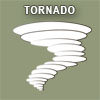How to Specify Special-Purpose Steel Doors and Frames
In our recent survey of architects around the US, many of you said you are seeing an increased need for thermal break steel frames. When we asked what was driving the demand, responses varied from “model codes” to “state codes”, or sometimes simply “owner’s preference”.

What’s the fuss about?
The high thermal conductivity of metal allows heat or cold from the exterior of a building to transfer to the interior via steel frames. Thermal break frames, however, have a separator material to break the conductivity. These energy efficient frames have a lower U Value and can reduce HVAC costs in regions with very hot or cold weather. Manufacturers of steel thermal break frames generally test to SDI-113 Standard Practice for Determining the Steady-State Thermal Transmittance of Steel Door and Frame Assemblies. They are available as door frames, transoms, sidelights, and borrowed lights.
As buildings are constructed to increasingly higher performance levels, the thermal performance of doors and frames will be hard to overlook. Many design professionals are choosing to specify thermal break frames to help meet their energy efficiency goals.
Special-Purpose Fire Door and Frame Assemblies

Architects should be aware of UL’s distinction between standard fire rated doors and “special-purpose” type fire doors. Many architects may have already specified what should have been special purpose assemblies without even realizing it.
What is a special purpose type fire door?
Referred to as product category GSXZ, UL’s complete definition can be found here. In essence, they are fire rated door assemblies with special construction or for special use, such as a fire rated blast resistant or fire rated specialty acoustic opening.
Why does this distinction matter?
Products that fall under UL GSXZ are rated as an assembly whereas other fire rated doors and frames are not. Rather than being able to mix and match the doors, frames, and hardware of your choosing, an assembly of products must be married together instead. This limits the breadth of products available for these openings and reduces the available options such as hardware or gaskets.
For further information about UL Certifications of fire doors and how the products should be marked or used, please refer to the UL Online Certifications Directory.
High Performance Steel Doors
The natural strength of steel makes it an ideal door material for specialty openings. Even when other door materials have special cores or modifications, they are often still unable to achieve the performance of steel.
The most common specialty steel door products are listed below in order of how much they are viewed on our website. Click the tiles for more information and a list of SDI Certified manufacturers of those products.









 .
. 


